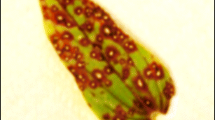Abstract
Alternaria alternata is well known as a producer of tentoxin as well as some other phytotoxic substances. A new method to prepare protoplasts fromAlternaria alternata, suitable for many purposes, was developed. By use of a mixture of lytic enzymes fromHelix pomatia, andTrichoderma harzianum with the commercial preparation “novozym,” it was possible to prepare protoplasts from all stages of fungal development, including the tentoxin production phase. Optimal incubation conditions led to the conversion of 1 g (wet wt) mycelial cells into 2.3–2.5 × 107 protoplasts within 3–6 h. Submerged as well as surface-grown mycelia were suitable. Optimal stabilization of protoplasts was obtained in 0.8M KCI. The protoplasts were used for both mutagenic treatment and physiological studies. UV irradiation of protoplasts resulted in formation of hyperproducing mutants. Protoplasts were able to form tentoxin. The biosynthetic activity of protoplasts from surface-grown mycelium was 40% that of intact mycelia. Although intact submerged myclia did not synthesize tentoxin, protoplasts of both types of mycelia produced this toxin, indeed protoplasts from submerged mycelia were even more active than those from surface mycelia. Neither oxygen tension nor mechanical stress during the shaking culture is the reason for the lack of tentoxin production by intact submerged mycelial pellets. Since tentoxin-synthesizing enzymes were apparently present in both mycelial types, it is probable that metabolites or lytic products in the pellets inhibit tentoxin-forming enzymes under submerged conditions.
Similar content being viewed by others
References
Durbin, R. D. and Uchytil, T. F. (1972),Phytopathology 62, 755.
Durbin, R. D. and Uchytil, T. F. (1977),Phytopathology 67, 602,603.
Schadler, D. L., Steele, J. A., and Durbin, R. D. (1976),Mycopathology 58, 101–105.
Steele, J. A., Uchytil, T. F., Durbin, R. D., Bhatnagar, P., and Rich, D. H. (1976),Proc. Natl. Acad. Sci. USA 73, 2245–2248.
Wickliff, J. L., Duke, S. O., and Vaughn, K. C. (1982),Physiol. Plant 56, 399–406.
Dahse, I., Müller, E., Liebermann, B., and Eichhorn, M. (1988),Biochem. Physiol. Pflanzen 183, 59–66.
Brücker, B., Hänel, I., Hänel, F., and Tröger, R. (1983),Z. Allg. Mikrobiol. 23, 549–556.
Oertel, B. (1983), Untersuchungen zur Physiologie und Kinetik der Tentoxindildung beiAlternaria alternata (Nee ex Fr.),Dissertation, Freidrich-Schiller-Universität Jena.
Edel, B., Brückner, B., and Tröger, R. (1985),J. Basic Microbiol. 25, 155–160.
Hänel, I., Liebermann, B., Brückner, B., and Tröger, R. (1985),J. Basic Microbiol. 25, 365–371.
Hänel, I. (1985), Untersuchungen zum Phosphat- und Acetateinfluss auf die Bildung des Phytoeffektors Tentoxin durchAlternaria alternata (Fr.) Keissler,Dissertation, Friedrich-Schiller-Universität Jena.
Liebermann, B. (1989), Wirkstoffsynthese durchAlternaria alternata unter besonderer Berücksichtigung cyclischer Peptide,Dissertation, Prom. B, Friedrich-Schiller-Universität Jena.
Bennett, J. W. (1985), Applications in biochemistry and genetics, inFungal Protoplasts, Peberdy, J. F., and Ferenczy, L., eds., Dekker, New York, pp. 189–204.
Brückner, B., May, R., and Loeffler, B. (1990),J. Basic Microbiol. 30, 147–152.
Liebermann, B., Ramm, K., and Baumann, E. (1992), Die analytische Erfassung der cyclischen Tetrapeptide Tentoxin und Dihydrotentoxin und deren Bausteine, inVom Organismus zum Molekül. Physiologische Prozesse, ihre Modellierung und Beeinflussbarkeit auf verschiedenen Ebenen, Dahse, I., ed., Friedrich-Schiller-Universität, Jena/Universitätsverlag Jena, pp. 336–349.
Dales, R. B. G. and Croft, J. H. (1977),FEMS Microbiol. Lett. 1, 201–204.
Kirimura, K., Nakajima, I., Lee, S. P., Kawabe, S., and Usami, S. (1988),Appl. Microbiol. Biotechnol.,27, 504–506.
Cary, J. W. and Stovall, M. E. (1992),Lett. Appl. Microbiol. 14, 100–103.
Junwai, C., and Shuyun, C. N. (1988),FEMS Microbiol. Lett. 50, 1–4.
Keller, U., Zocher, R., and Kleinkauf, H. (1980),J. Gen. Microbiol. 118, 485–494.
Author information
Authors and Affiliations
Rights and permissions
About this article
Cite this article
Ramm, K., Brückner, B. & Liebermann, B. Biosynthesis of the phytotoxin tentoxin. Appl Biochem Biotechnol 49, 35–43 (1994). https://doi.org/10.1007/BF02888845
Received:
Accepted:
Issue Date:
DOI: https://doi.org/10.1007/BF02888845



